PIEVE SANTO STEFANO
Brancialino Castle
Located on the border of the Tuscan Valtiberina, today it dominates Lake Montedoglio
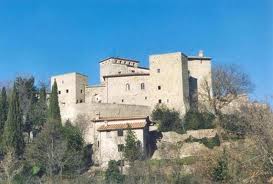
The origins of the Brancialino Castle date back to the 12th century, but the place must have been inhabited already in Roman times. It stands in a strategic and isolated position on a hill from which it dominates the lake of Montedoglio, once the valley where the Tiber river flowed. After years of neglect and abandonment it has been the subject of a careful restoration and today it houses an accommodation facility. The Castle, which cannot be visited freely, can be reached along the Marecchiese state road SP 258 which connects Sansepolcro with Badia Tedalda.
Castle of Mignano
The castle that dominates the valley of the Ancione stream
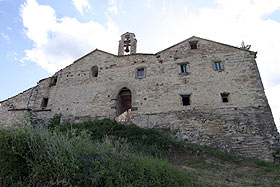
The castle still retains its ancient appearance and dates back to the 11th century when, for defensive purposes, it was erected on the top of a hill in the valley of the Ancione stream, 589 meters high, which allowed a wide view over the whole area. surrounding. The original nucleus is the one on the top of the hill, occupied by the tower and the keep; subsequently the castle developed further, creating a unitary and harmonious set of volumes. The eastern front, built directly on the rock, presents in a single context the gabled elevations of two buildings connected by an intermediate structure in which there is a beautiful door with a pointed arch formed by worked stone blocks, in line with the path uphill in steps that crosses the whole nucleus. On the same front of the castle stand out the bell gable of the church of S. Andrea, set perpendicular to the entrance door and two windows with large exposed stonework. The castle church is mentioned in a document of 1085 as S. Donato di Mignano, in another act of 1231 the name of S. Andrea della Torre appears for the first time. The castrum is closed at the western end by the keep with a corner tower; these buildings have construction characteristics and architectural details identical to those of the east front and with a small stretch of walls still visible in a building on the south side, they constitute the only original parts of the castle. The tower, which remained intact in its original structure, but probably decapitated following a collapse, still preserves intact the small stone-framed windows and the entrance door, now walled up, with a Renaissance lintel.
ANGHIARI
Montauto Castle
The castle that enchanted San Francesco on his way to La Verna
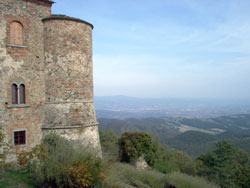
The castle had its origin around 1170/80, a historical period in which the lords of Montauto are mentioned for the first time as feudal lords. The power and importance of the castel are documented by the triple walls that characterized it and by the mighty keep. Its happy position made it practically unassailable, perched on a 700 meter high ground surrounded by the rocks of the mountain and the overhang of the Sovara river valley. Around the early years of the sixteenth century it was conquered by the Florentines who stole all its treasures and, after almost total destruction, it was rebuilt in the Renaissance period. Montauto was also a frequent destination of San Francesco during his travels from La Verna and until 1503 a cassock was kept in the castle chapel that the saint left to his friend Count Alberto. Precisely in this year the castle was conquered by the Florentines and all its treasures were stolen. Almost totally destroyed following ups and downs, the castle was rebuilt in the Renaissance period. The most evident sign of this phase is the beautiful conical corner tower with strong scarp, facing the access road, attributed to the architect Francesco di Giorgio Martini. The stone mullioned windows and the elegant finishes of the loggias date back to later times, when the castle became a manor house. In addition to the aforementioned small chapel , Montauto also has a larger church with a beautiful carved portal and a fortified external front. The whole complex is still owned by the family of the Barbolani da Montauto counts and cannot be visited freely. It can be reached on foot with an easy path that starts at La Fabbrica della Natura, the visitor center of the Parco dei Monti Rognosi and Valle del Sovara, or comfortably by car along the provincial road of Libbia to Tavernelle di Anghiari.
Pianettole Castle
Beautiful example of a medieval fort
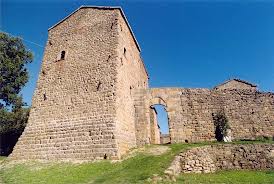
Pianettole is a beautiful example of a medieval fortress kept in a fairly good state of conservation, in which the high stone walls, the arched door which is the only access inside the walls and the mighty tower with a base are evident. shoe. The tower is still divided by wooden floors connected by stairs, while on the first floor there is a fireplace. Built by the lords of Montauto, the castle was donated to the Camaldolese in 1142. The mighty keep is placed in defense of the only access door, along the western curtain, near the north-west summit. The front facing south is characterized by the presence of a massive square tower, while the eastern one overlaps for most of its length on the outer wall of the parish church of SS. Peter and Paul. On the north-west corner there are the ruins of a primitive barbican, with still clearly visible two loopholes, placed in greater control of the road coming from the valley floor. Approximately in the center of the western front, dominated by the keep, there is a beautiful portal with a lowered round arch, the only access to the enclosure. Inside the castle there are some buildings, in addition to the aforementioned parish church with a small bell gable, and a well. Today the castle is privately owned, houses an accommodation facility and can only be visited externally.
Sorci Castle
The mighty residence of the Captain of Ventura Baldaccio Bruni
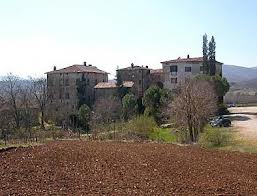
The castle of Lombard origin belonged to the Barbolani of Galbino in the 12th century. The toponym Sorci derives from the Germanic 'sorku', which means heath, scopeto therefore 'place of scrub brooms' that were and still are part of the local vegetation. Owned by the Tarlati family starting at the beginning of the fourteenth century, it was subjected to Florentine domination in 1385 and later became the home of the mercenary captain Baldaccio Bruni, defined by Niccolò Machiavelli "an excellent man in war, because in those times he was no Italy that surpassed him in virtue of body and soul ". Baldaccio was treacherously killed and beheaded on 6 September 1441, which is why it is said that his ghost still lingers in the halls of this ancient manor shifting armor and dragging noisy chains. Today the castle is home to an inn and can be visited on some public occasions. It can be reached along the road that connects Anghiari to Monterchi.
Villa La Barbolana
A rare example of a fortified villa in Arezzo
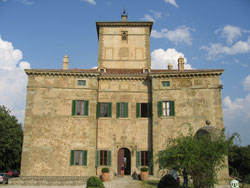
Originally a stately home, located in an excellent panoramic position on the south-eastern slopes of Montauto, it was built by Federigo di Antonio Barbolani in the second half of the 16th century. A rare example in Arezzo of a private fortified villa, it consists of a two-storey square-plan building with four projecting corner bastions , a central tower and two entrances consisting of bridges over the moat that surrounded the building. Inside, the rooms are largely with vaulted roofs, terracotta floors and Renaissance stone portals: on the ground floor, in what is currently the dining room, there was a chapel dating back to the 18th century until 1850. Modernized in the nineteenth century. on the occasion of the marriage between Carlotta Barbolani and Simone Francesco Velluti-Zati, Duke of S. Clemente, the villa was the subject of a recent restoration which involved the reconstruction of the south facade and the interiors, carried out with care by many different craftsmen under the 'careful coordination of the current owner. La Barbolana, a private home, can be easily reached from the hamlet of Tavernelle di Anghiari.
Galbino Castle
The ancient noble residence of the Counts of Montauto
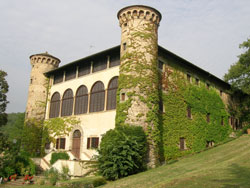
Located between a tributary of the Sovara and the Provincial Road of Libbia (SP 43), Galbino is the most evident example of an ancient castle whose original structure has been significantly modified to be used as a noble residence. Feudal residence of the Counts of Montauto until the end of the 18th century, today it has a rectangular layout, a turret in the center of the roof and cylindrical towers placed at the corners. On the facade an elegant loggia with stone columns, closed with wooden frames. The castle is clearly visible from the top of the road that connects the hamlet of Tavernelle with the former Convent of San Niccolò in Gello. The building is privately owned and cannot be visited freely.
ANCIENT RUINS
The ruins of the castles: still numerous testimonies on the territory
best preserved castles , due to historical events and because they are being restored, are difficult to visit as they host private homes or accommodation facilities. Much simpler but still fun is the visit to the ruins of the castles that have suffered the most from the passage of time, which can be reached with a short walk in nature after leaving the car.
Valialle
The origins of the castle date back to the 13th century. Only a few tracts of the original walls remain, while the nucleus is used for rural dwellings. The internal church, dedicated to S. Biagio , has Romanesque shapes, a single nave, with a semicircular apse and a bell gable: reopened to the public in the summer of 2004, it preserves Romanesque capitals and a painting representing the Virgin in glory with Saints Biagio and Romualdo. Like Pianettole, Valialle was also linked to the order of the Camaldolese: destroyed by Florence, the Porta Nuova ( or Fiorentina) of Anghiari was built with its stones in 1460. To reach Valialle you have to follow the road that leads from Anghiari to Toppole and turn right before reaching Molino del Caccia.
Castiglion Fatalbecco
The castle has Lombard origins and in the course of history it has belonged to the Counts of Galbino and to the Camaldolese monks. The ruins of the castle, which show themselves surrounded by a forest of pines and cedars of Lebanon, are located on the top of the Poggio di Castiglione, in the Rognosi Mountains. They can be reached by walking along the path 104 for about 3 kilometers from the locality of Carmine, near Anghiari, or the path 104 / B (about 2 kilometers) which branches off to the right, before the hamlet, along the road that joins Anghiari. in Ponte alla Piera.
Montedoglio
The castle was destroyed during the Second World War by British bombing, to hit a German military post that had settled there. It stood on a hillock on the left side of the Tiber valley, now occupied by Lake Montedoglio. The name Montedoglio probably derives from Monte d'Oro, a name due to the golden aspect of the ophiolithic rocks that make up the hill. From Gragnano, part of the municipality of Sansepolcro, you reach the locality of San Martino. From there you walk up to the top of Poggio di Montedoglio which, in addition to the ruins of the castle, offers an enchanting view of the lake and the Valtiberina.
Montautello
The castle of Montautello, near Monterchi, stood strategically on the right bank of the Cerfone and was part of the interesting system of castles and towers of the Val Cerfone. Its ruins are partly reconquered by nature but testify to its ancient grandeur. From Scandolaia, a town near Le Ville di Monterchi, proceed until the road turns white. In the vicinity of a stone fountain, turn left and you will reach a group of houses having to leave the car. The castle is about a hundred meters away, to be traveled through meadows and woods.








 Home
Home